18 May 2020 | Draft
Eliciting Insight from Mandala-style Logos in 3D
Interactive engagement with mandalas and yantras in virtual reality
-- / --
Commentary on 3D models
Interactive displays in virtual reality
--
Mereon trefoil knot
--
Crown chakra (Sahasrara)
-- Framing ring dynamics in relation to symmetrical polyhedra
--
Interlocking tori with complementary rotations
--
Mnemonic aid to "location" of metasphere?
--
Circle of 64 hexagrams (Shao Yong)
--
Symbols of Abrahamic religions
--
Ten Oxherding Images of Zen
--
Ouroboros
--
Tao / Ying-Yang symbol
--
Lauburu symbol of Basque culture
Circulation through octants of the globe
Comprehension of complexity and paradox through 3D "mandalas"
--
Concordian mandala?
Examples of other interactive displays of potential relevance
--
Mandelbrot set rendering on the complex plane
--
Szilassi polyhedron
--
Nesting Platonic pokyhedra
--
Polyhedral edge displacement
--
Coronavirus as a spherical mandala?
Technical note on X3D and X3DOM
Commentary on 3D models
This exploration follows from interaction with the Scientific and Medical Network, which uses a mandala-style logo to indicate its focus on exploration of new paradigms with an emphasis on consciousness. The question raised here is whether mandalas imply insight which could be elicited to a greater degree through animation, representation in 3D, and the possibility of user interaction.
It is not however a matter of seeking to exhaust the significance which may be inferred from such configurations, rather it is a question of whether advances in visualization technology, and dissemination of imagery over the web, can enable new possibilities for many. Of particular relevance is the tendency to use centro-symmetrical logos in the style of yantras and mandalas to such more fundamental comprehension of integration..
As an illustrative introduction to development of the argument with respect to interactive animations in virtual reality, a simple possibility of animation of the logo of the Scientific and Medical Network is shown below. What do the design constraints and possibilities then suggest?
| Adaptations of the logo of the Scientific and Medical Network | ||
| Jerky rotation | Static original | Smoother rotation |
 |
 |
 |
Positive versus Negative? A further issue is the valuable challenge to any assumption that such logos are a focus or container for the "positive" and desirable only -- thereby designing out the "negative" and undesirable. Arguably the more fundamental challenge is to find ways of using the implied cogitive dynamics of such configurations so as to contain both positive and negative in a more fruitfully integrative manner.
A valuable metaaphor in that respect is the design of electrical circuits. These require two wires in order to carry positive and negative currents, whether directly or by alternation. Stripping out one wire to eliminate the negative is neither feasible nor desirable. The argument has been developed otherwise by Barbara Ehrenreich (Bright-sided: how the relentless promotion of positive thinking has undermined America; Smile Or Die: how positive thinking fooled America and the World, 2009). The argument clearly has implications for the emerging trend towards suppressing all communications on the internet which use any form of negative expression.
Psychosocial motors and dynamos? The argument with respect to postive-negative is inspired by the remarkable innovations of Nikola Tesla at the beginning of the last century regarding the rotation of magnetic fields enabling dynamos and electrical motors (Reimagining Tesla's Creativity through Technomimicry: psychosocial empowerment by imagining charged conditions otherwise, 2014). An analogue was specifically discussed and illustrated in the latter, as reproduced below (Potential implications of alternation and rotation in psychosocial fields, 2014).
The animation on the right is an adaptation of the Sri Yantra of the Shri Vidya school of Hindu tantra. The central part is formed of nine interlocking triangles that surround and radiate out from the central point. As being suggestive of cognitive "wiring", the set of triangles is rotated through three positions at the same rate as that of the animation on the left.
| Potential correspondences between electrical and cognitive cycles? Experimental 3-phase animation of classic Sri Yantra (core "wiring" configuration) |
|||
| Magnetic field and vectors from 3-phase coils (reproduced from Wikipedia) |
Animation through 3 phases |
Animation through 8 phases |
Animation through 16 phase |
 |
 |
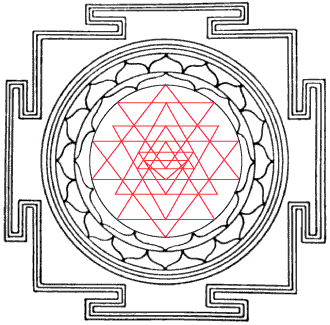 |
 |
As a further experiment, the set of triangles is rotated at the same rate through 8-phases and 16-phases (above right). Clearly further experiments of mnemonic significance could be undertaken by rotating different triangles at different rates, possibly differently coloured.
The argument can be developed further with other imagery (Representation of Creative Processes through Dynamics in Three Dimensions, 2014). The animations above raise the question of how they might be represented in 3D and what further insight they might then enable. The point is developed further through experimentation with the display of the "1,000 petalled" crown chakra below -- with 20 rings of 50 petals.
| Adaptations inspired by the logo of the Scientific and Medical Network (variously suggestive of positively-negatively charged dynamics) |
||
| Alternation of charges | Static original | Rotation of whole |
 |
 |
 |
| Many variations of colour, rotation, rate and directional arrows can be explored | ||
Interactive displays in virtual reality
The technical problem with respect to interactive web dissemination has been the constraint (notably for the author) of enabling representation in virtual reality rather than simply presenting videos or animated gifs. This is despite being able to generate such interactive 3D models locally with other software protocols (X3D, VRML).
Such interactivity can however be offered over the web in some cases by embedding such displays using X3DOM technology (Anestis Koutsoudis, Bring Cultural Heritage 3D Content on the Web Using the X3DOM Framework, Connecting ARchaeology and ARchitecture in Europeana / Athena Research and Innovation Centre).
Access to a number of dynamic centro-symmetric displays is offered below. Some derive from the design metaphors and themes illustrated in 2D animations/projections in the imagery below. Some may not work, depending on the speed of the internet connection, especially for the more complex. Conventional video alternatives are indicated for convenience in the event of difficulty, although that option is not the purpose of this presentation.
Mereon trefoil knot: Some possibilities are discussed separately (Minimal knot of requesite complexity, 2022)
| Interactive 3D demos | Indicative screen shots / animations (click for 3D) |
 |
| (click for 3D) | |
 |
|
| With nested Platonic polyhedra | (click for 3D) |
 |
Crown chakra (Sahasrara): The possibilities and significance are discussed separately (Global Insight from Crown Chakra Dynamics in 3D? Strategic viability through interrelating 1,000 perspectives in virtual reality, 2020) namely the so-called "1,000 petalled lotus", for which a variety of dynamic 3D models are presented and discussed in Crown chakra as circular configuration of rotating heart-patterns; Construction of crown chakra in 3D using a twisted torus; Crown chakra embodying gimbal dynamics to frame the Axis Mundi (2020). Arguably this is an extreme variant of the mandala-yantra metaphor. That shown below has the configuration of 20 concentric rings of 50 petals rotating in the plane of the page.
| Interactive 3D demos | Indicative screen shots / aAnimations (click for 3D) |
| 20 Rings flat and mutually rotating | |
|
 |
| 20 Rings stacked and mutually rotating | (click for 3D) |
 |
|
| 20 Rings stacked with additional dynamics | (click for 3D) |
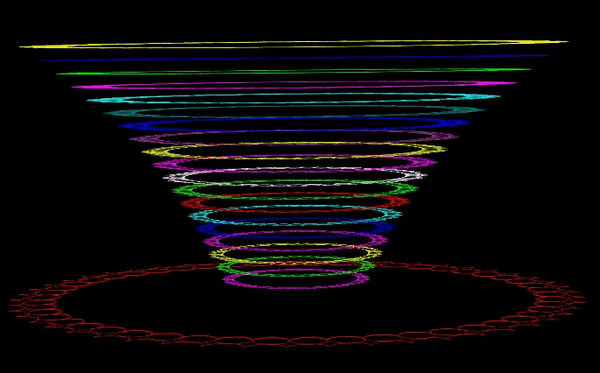 |
|
| Complex possibility: gyroscopic movement of selected rings | (click for 3D) |
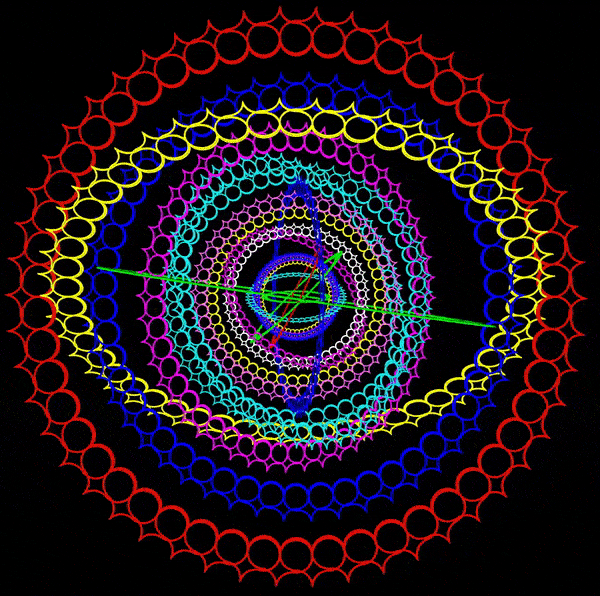 |
|
| Complex possibility: movement of 20 rings through a torus | (click for 3D) |
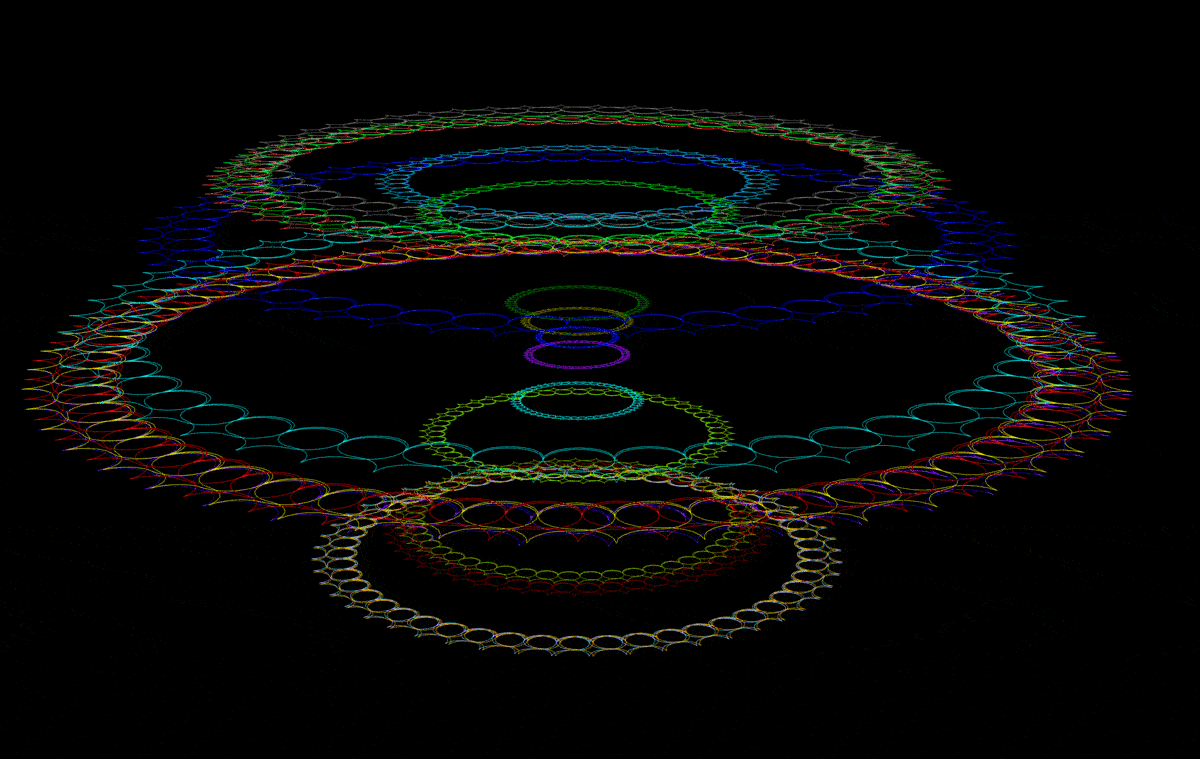 |
|
Framing ring dynamics in relation to symmetrical polyhedra:
| Interactive 3D demos (click to access) | Indicative screen shots / animations (click for 3D) |
 |
Interlocking tori with complementary rotations:
| Interactive 3D demos (click to access) | Indicative screen shots / animations (click for 3D) |
 |
Further possible insights are discussed in relation to the crown chakra (Global Insight from Crown Chakra Dynamics in 3D? Strategic viability through interrelating 1,000 perspectives in virtual reality, 2020)
| Interactive 3D demos (click to access) | Indicative screen shots / animations (click for 3D) |
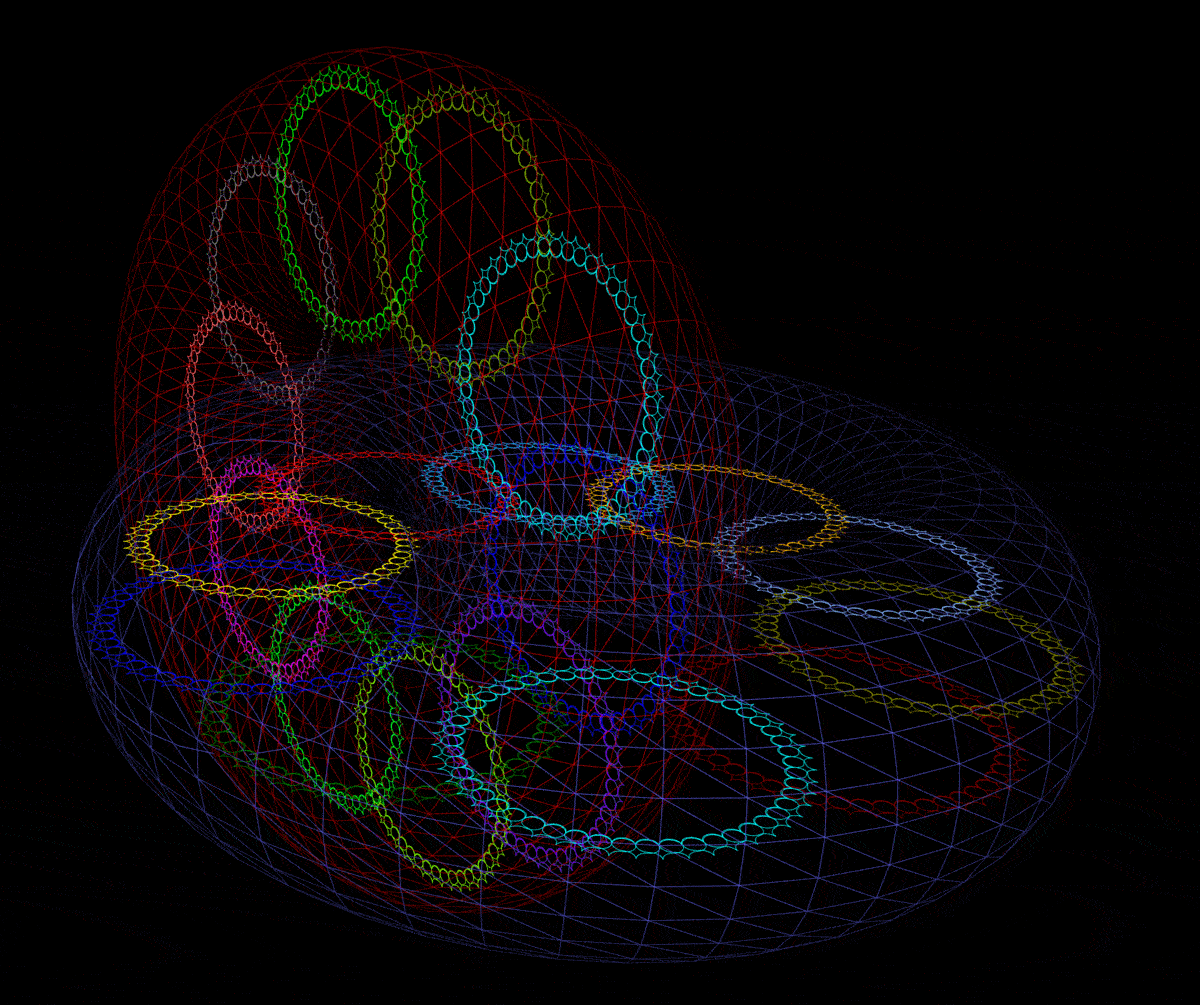 |
Mnemonic aid to "location" of metasphere?
| Interactive 3D demos (click to access) | Indicative screen shots / animations (click for 3D) |
 |
Circle of 64 hexagrams of Shao Yong: For which a variety of configurations are presented and discussed in Toroidal constraint -- nuclear fusion as metaphor of cognitive fusion (2019). That shown below is a configuration of 3 mutually orthogonal rings of hexagrams each rotating within a drilled truncated cube -- a toroidal polyhedron with 64 edges.
| Interactive 3D demos (click to access) | Indicative screen shots / animations (click for 3D) |
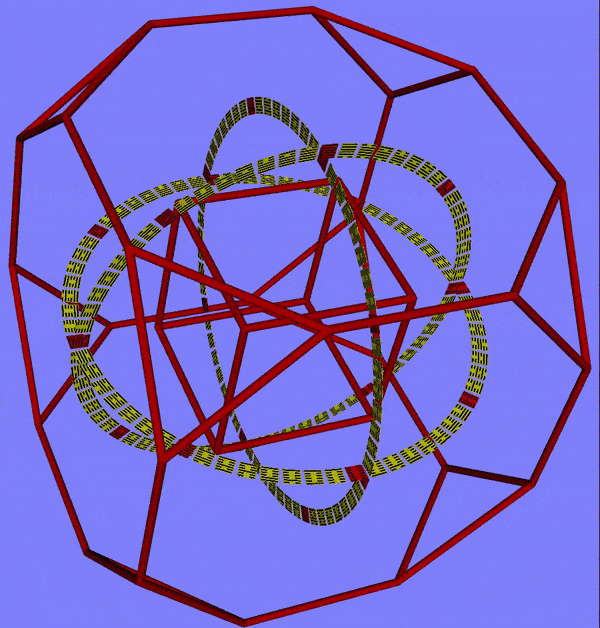 |
Symbols of Abrahamic religions: As an exercise in projective geometry, a mutually orothogonal rendering can be explored (Reconciling Symbols of Islam, Judaism and Christianity, 2017; Mutually orthogonal Abrahamic symbols from the perspective of projective geometry, 2017). With respect to the Star of David, various dynamics of "cognitive cycles" can be speculatively rendered in a 3D development as the Merkabah (Cognitive implication in Merkabah as configuration of cycles essential to systemic viability, 2017)
| Interactive 3D demos (click to access) | Indicative screen shots / animations (click for 3D) |
|
 |
|
 |
Ten Oxherding Images of Zen: The value of displaying the classic set of images in a torus can be explored, as explained separately (Zen of Facticity: Bull, Ox or Otherwise? Herding facts and their alternatives in a post-truth-era, 2018; Phases in the "Re-cognition" of "Bull" according to Zen? Experimental attribution of significance to traditional distinctions, 2017). The design metaphor is also discussed there in relation to the Chinese BaGua mirror pattern of 8 trigrams, especially in the light of reference to an 8-fold ox herding set (The Eight Ox Herding Pictures, 2012; The Eight Ox Herding Pictures: a Chan/Zen allegory) -- as illustrated below.
| Interactive 3D demos (click to access) | Indicative screen shots / animations (click for 3D) |
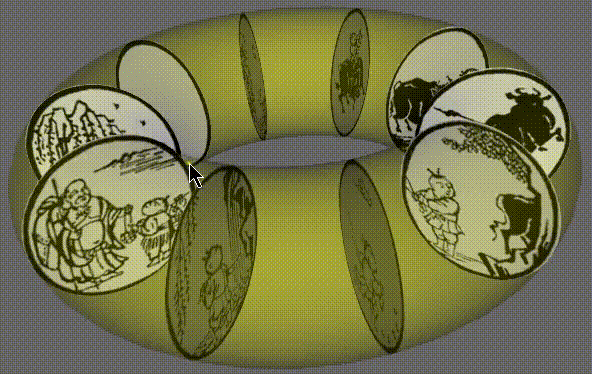 |
|
|
 |
Ouroboros: As an ancient symbol depicting a serpent or dragon eating its own tail, the Ouroboros entered western tradition via Greek magical tradition and was adopted as a symbol in Gnosticism and Hermeticism and most notably in alchemy. It continues to be recognized as the most fundamental symbol of eternal return -- inviting exploration in 3D (Experimental animations in 3D of the ouroboros pattern, 2017).
| Interactive 3D demos (click to access) | Indicative screen shots / animations (click for 3D) |
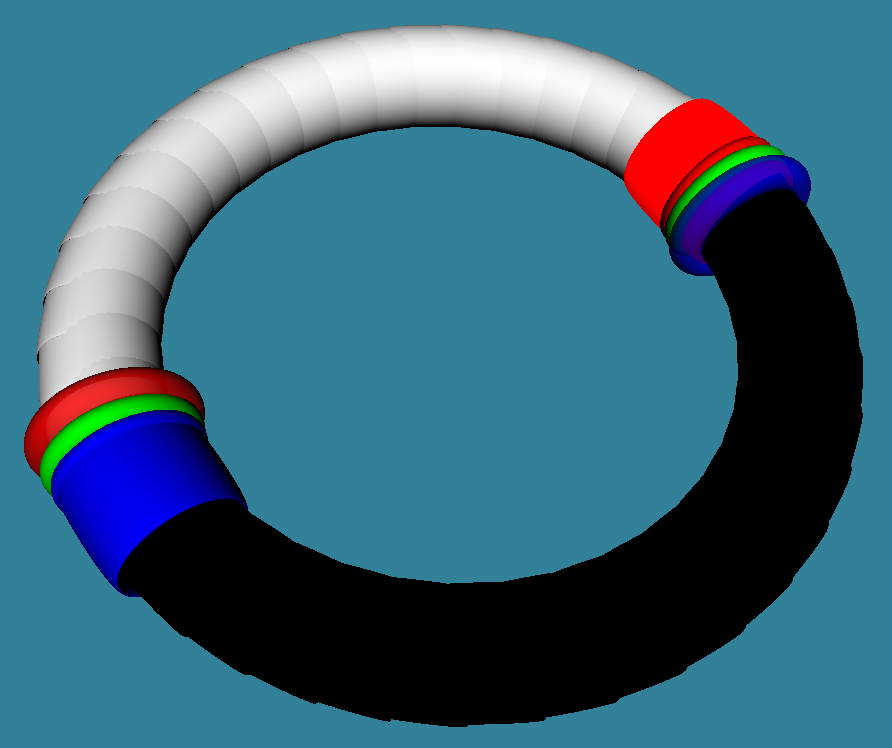 |
Tao / Ying-Yang symbol: As one of the most fundamental symbols indicative of the transcendence of dualism, conventionally displayed in 2D, there is a case for exploring the possibilities of interacting with it in 3D (Exploring Representation of the Tao in 3D: virtual reality clues to reconciling radical differences, global and otherwise? 2019). As noted and indicated in the latter, an early draft of the 3D models encouraged the elaboration of models using far more professional techniques -- as presented below. They were prepared by Sergey Bederov of Cortona3D, -- to whom thanks are due for permission to include them in this document. Provocatively it could be said that forms appropriate to the reconciliation of opposites in society call for some kind of "Parametrization of the Tao", or perhaps the "Parametrization of Yin-Yang". The economy of the coding required for the models is suggestive in that respect -- to the extent that the mathematics is comprehensible.
Interactive 3D demos (click to access) |
Indicative screen shots / animations (click for 3D) |
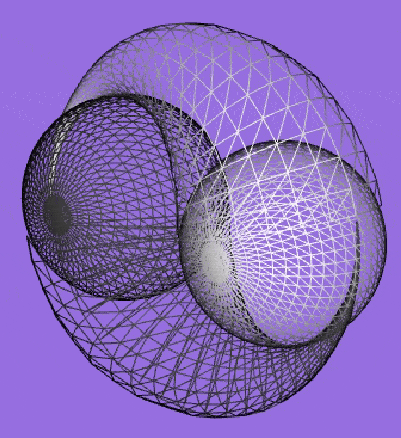 |
|
 |
| Experimental animations of paired elements of 3D Tao symbol (solid and wireframe renderings) | |||
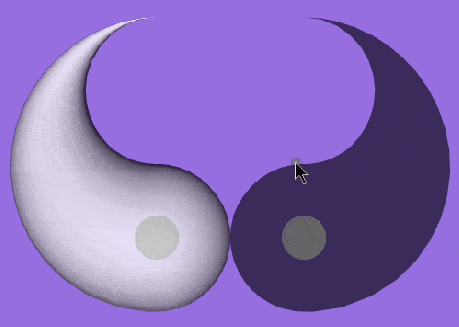 |
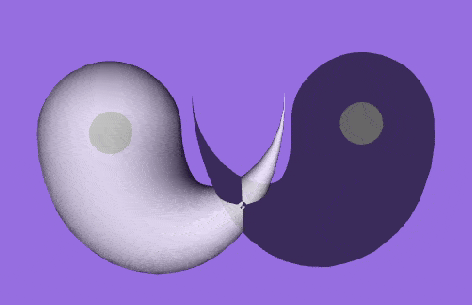 |
 |
 |
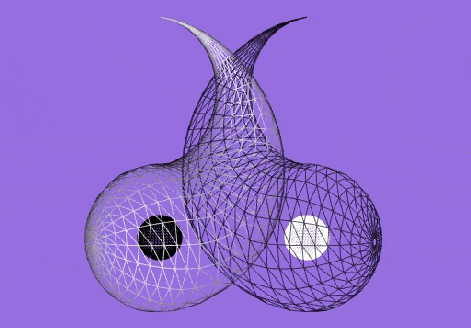 |
 |
 |
 |
| Using "droplets" extruded according to the model of Sergey Bederov (above) | |||
Lauburu symbol of Basque culture: The symbol, and the possibility of configuring it significantly in 3D, is discussed in the following:
- Improvisation in Multivocal Poetic Discourse: Basque lauburu and bertsolaritza as catalysts of global significance (2016)
- Experimental animation of the Smith Chart in relation to the Tao and Lauburu symbols in:
- Cross, swastika variants and lauburu (2008) as a section of Sustainability through Magically Dancing Patterns (2008)
- 24-fold Pattern Implied by Dynamics of the Lauburu in 3D: visualization of the interplay of sets of voices in discourse (2016)
| Interactive 3D demos (click to access) | Indicative screen shots / animations (click for 3D) |
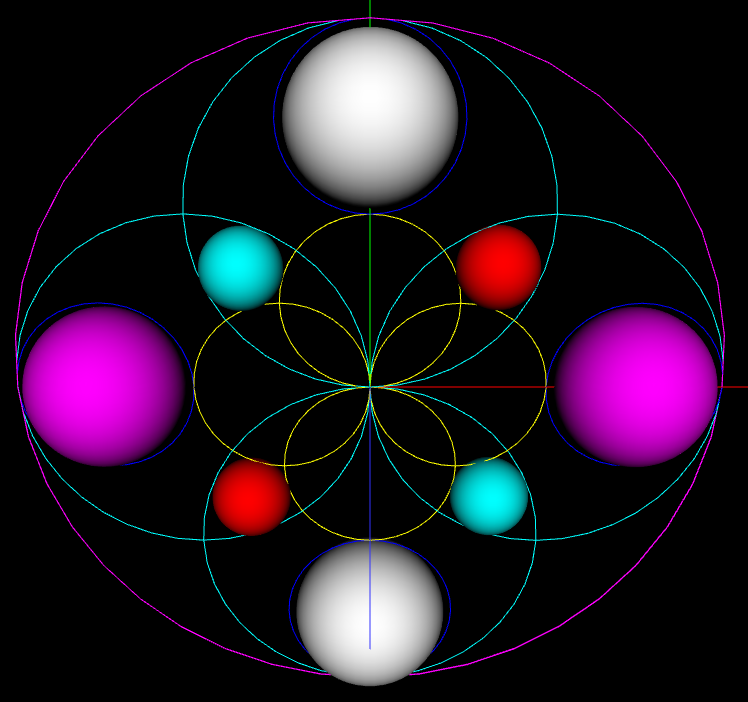 |
|
 |
|
|
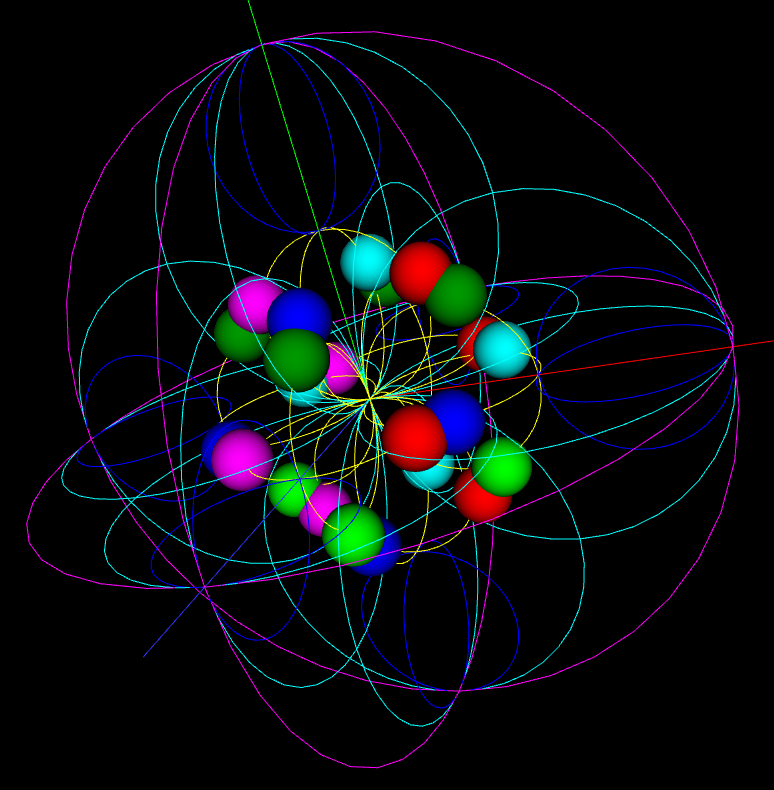 |
Circulation through octants of the globe
The following interactive experiments are part of a more general argument Challenge of 144 Distinctions -- Mahjong as "Angels" versus "Demons": visualization of archetypal gaming in 3D as "I-magic" (2020). The sections of that argument regarding the following experiments are Game ball design as holding insight of relevance to global governance? and Non-linear pathways curving between octants
Interactive 3D demos (click to access) |
Indicative screen shots / animations (click for 3D) | |
 |
 |
|
|
 |
 |
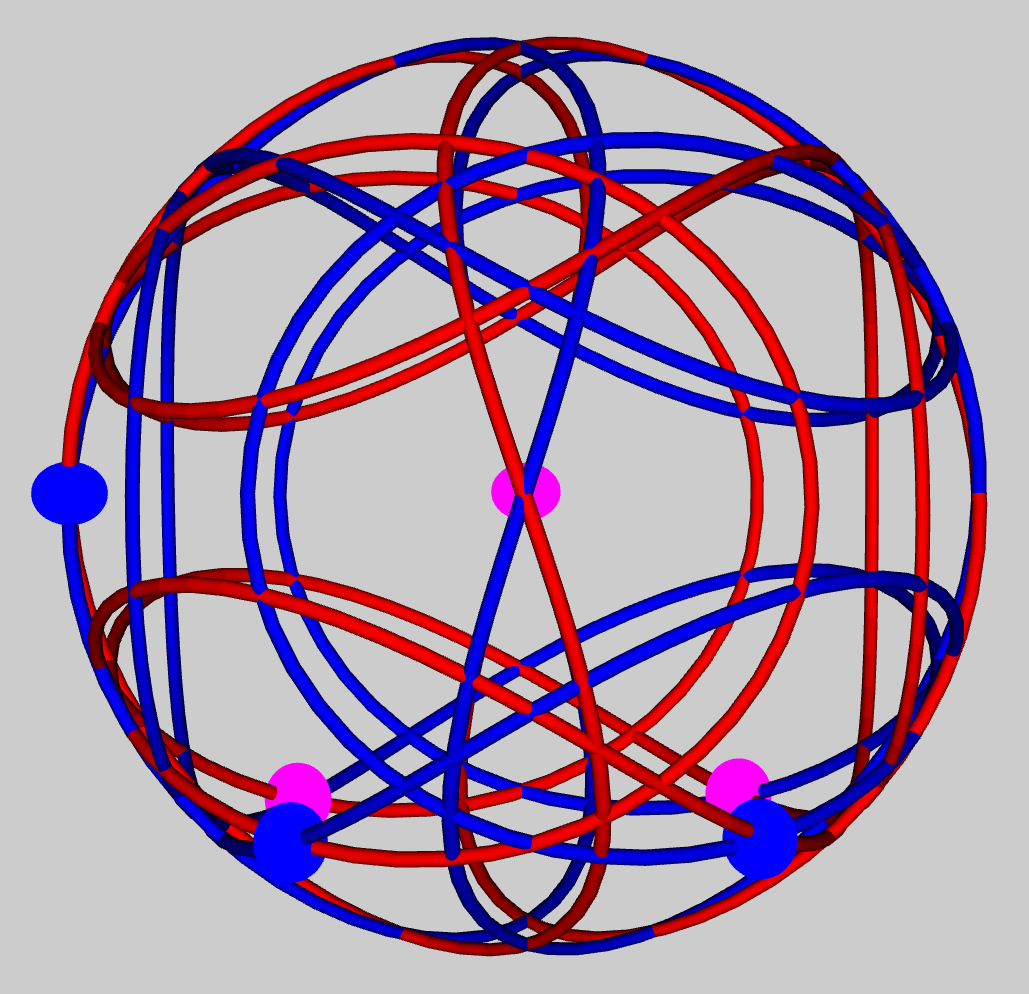 |
 |
|
Comprehension of complexity and paradox through 3D "mandalas"
Logos and mandalas endeavour to render succinct and communicable a nexus of complexity by which paradox and subtlety may be inferred. An indicative example is that chosen by the International Mathematical Union (as displayed below right). This is a representation in 3D based on the iconic Borromean rings -- typically displayed in 2D. The configuration is especially valued in mathematics since the three topological circles are linked -- but such as removing any one ring leaves the other two unconnected. In other words, no two of the three rings are linked with each other, but nonetheless all three are linked. The images are reproduced from a separate discussion (Engaging with Elusive Connectivity and Coherence: global comprehension as a mistaken quest for closure, 2018).
| Examples of 3-fold articulations of Borromean rings of relevance to coordination of political systems? | ||||
| Representation of rings interlocking according to the Borromean condition | ||||
| Early depiction of Christian Trinity |
Common representation in 2D |
Distorted representation as ellipses |
3D representation | International Mathematical Union Logo |
 |
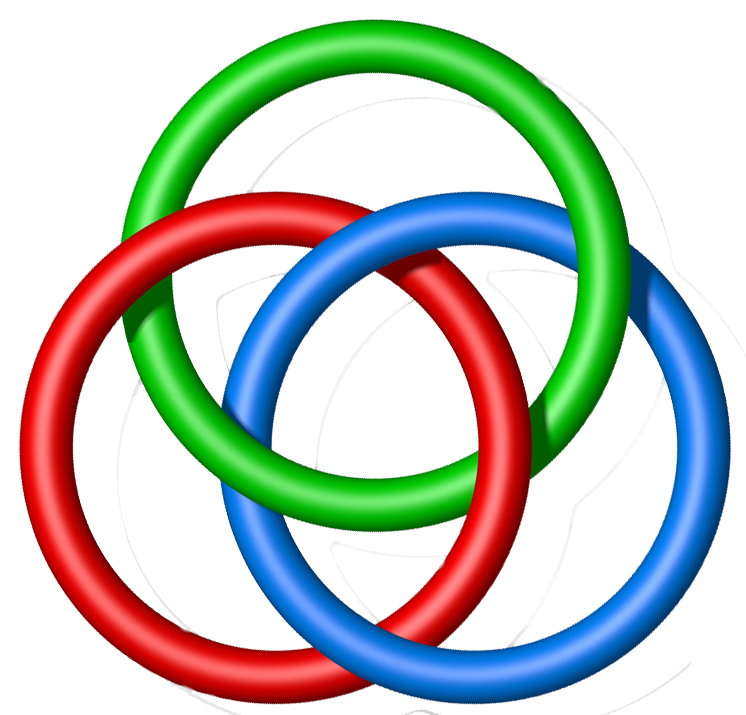 |
 |
 |
 |
| Reproduced from Wikipedia | ||||
The earlier discussion of Borromean rings included the development of 3D animations (as shown below) consistent with the focus of the argument here. It includes comments of relevance by Louis H. Kauffman (The Borromean Rings: a tripartite topological relationship. 2006).
The animation on the right bewlow shows three mutually orothogonal tori with a 3-loop helix moving over each of them (Video: mp4).
| Representations of Borromean rings (with Red surrounds blue; Blue surrounds green; Green surrounds red) |
Mutually orthogonal tori with 3-loop helix |
||
| As an ordered knot-set | Toroidal version |
3 Möbius strips (animation) | |
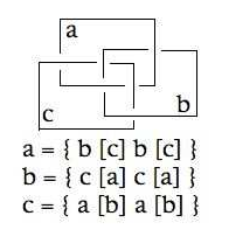 |
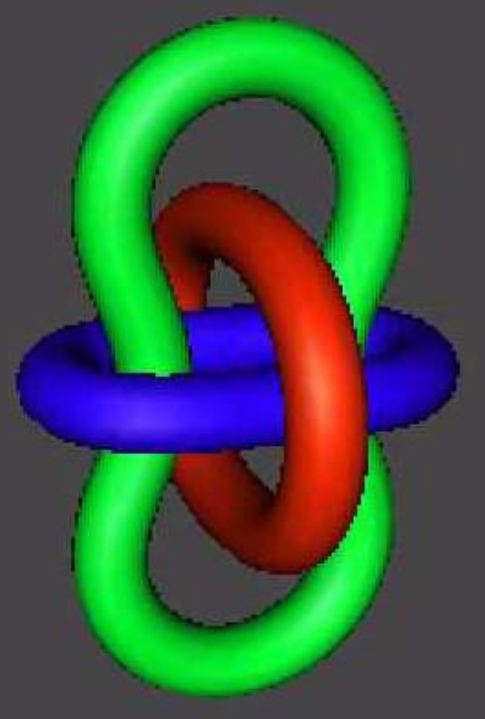 |
 |
 |
| Reproduced from Kauffman (2013) | Reproduced from Kauffman (2006) | Video (mp4); Virtual reality (x3d; wrl) | Interactive variants (x3d, wrl) . |
Concordian mandala? Provoked by the multiple Borromean rings configuration of five loops -- namely the Discordian Mandala used as a symbol in Discordianism -- a question is how it might be possible to imagine and represent dynamically a comprehensible mandala of requisite complexity in virtual reality. This was the focus of separate discussionm firstly on the use of 5 nine-sided polygons, then on 5 nine-looped helical coils (shown with sphere movement around them):
- Visualization in 3D of Dynamics of Toroidal Helical Coils -- in quest of optimum designs for a Concordian Mandala (2016)
- Concordian Mandala as a Symbolic Nexus -- insights from dynamics of a pentagonal configuration of nonagons in 3D (2016)
- Con-quest Aesthetically Reframed via the Concordian Mandala (2016)
- Speculation on Potential Symbolic Relevance of the Concordian Mandala (2016)
Interactive 3D demos (click to access) |
Indicative screen shots / animations (click for 3D) |
 |
|
 |
Examples of other interactive displays of potential relevance
Mandelbrot set rendering on the complex plane: The complexity sciences attach significance to the complex plane on which the Mandelbrot set is typically rendered. Speculatively three such images may be displayed in a mutually orthogonal configuration as shown below, and discussed separately (Mandelbrot sets rendered in a mutually orthogonal configuration of 3 complex planes, 2019)
Interactive 3D demos (click to access) |
Indicative screen shots / animations (click for 3D) |
 |
Szilassi polyhedron: This unusually asymmetric polyhedron offers interesting possibilities when 6 of them are configured in rotation in a ring, as discussed separately (Association of the Szilassi polyhedron with cube inversion, Dynamics of discord anticipating the dynamics of concord, 2018)
Interactive 3D demos (click to access) |
Indicative screen shots / animations (click for 3D) |
 |
Nesting Platonic pokyhedra: Relative movement of nested Platonic polyhedra: pumping and rotation (2015)
Interactive 3D demos (click to access) |
Indicative screen shots / animations (click for 3D) |
 |
Polyhedral edge displacement: These models focus on the drilled truncated cube within which a simple cube can be understood as nested, as discussed separately (Psychosocial Implication in Polyhedral Animations in 3D, 2015)
Interactive 3D demos (click to access) |
Indicative screen shots / animations (click for 3D) |
 |
|
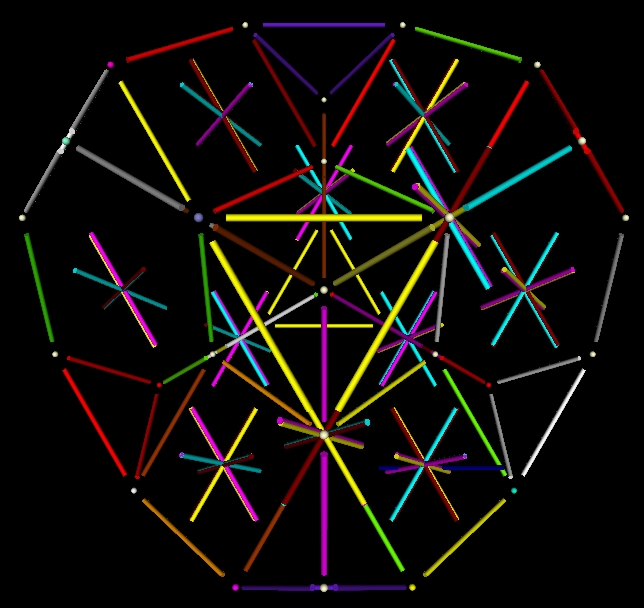 |
Coronavirus as a spherical mandala? The potential symbolic significance for a global civilization of the spherical form of the coronavirus merits exploration of dynamics in 3D of its 72 spikes (assumedly) that might be associated with its "operation", as variously discussed (Spike-endowed Global Civilization as COVID-19: humanity "bristles" as the world "burns", 2020; Reimagining Coronavirus in 3D as a Metaphor of Global Society in Distress: crowning pattern that connects spiky organisms, satellite constellations, nuclear explosions, and egomania? 2020; Cognitive Engagement with Spike Dynamics of a Polyhedral Coronavirus: alternation between assertive arrays and systemic patterns of comprehensible coherence, 2020).
Interactive 3D demos (click to access) |
Indicative screen shots / animations (click for 3D) |
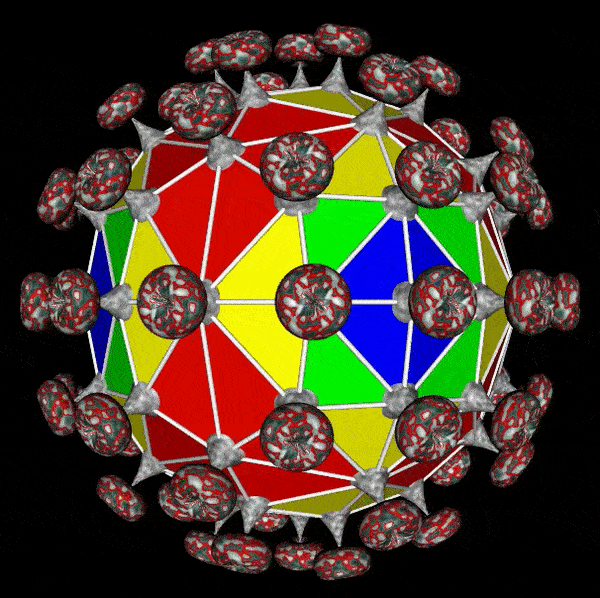 |
|
 |
Technical note on X3D and X3DOM
The visualizations variously presented are experiments -- best evaluated as "proof of concept exercises". They are constrained by the limited competence of the author in relation to the evolving protocols for the elaboration of such models and their dissemination over the web. Technical and aesthetic imperfections may be evident -- readily eliminated by professionals. Typically they suggest design alternatives and aesthetic improvements in terms of choice of colour, rate of movement and efficiency of coding, and access to informative viewpoints. Portions of the coding may be redundant or simply inefficient.
Many of the models -- especially the more complex -- have benefitted from the occasional advice and assistance of Sergey Bederov of Cortona3D, to whom thanks are due, although this implies no responsibility for the final result. This intervention has been vital to the efficient display of the crown chakra dynamics, especially when embedded within a torus -- given the constraints on the display of wireframe views via X3DOM, notably on a smartphone. A word of caution needs to be noted in that ongoing developments in X3DOM may disable displays currently operating satisfactorily.
The X3D models indicated above can be freely downloaded for further experimentation. Features of the models can be modified with a simple text editor -- and then viewed using applications that are freely available.
The ability to present over the web the models indicated here, which display correctly in 3D using such applications, is constrained by ongoing progress in development of the X3DOM facility -- in which they have been embedded in HTML pages (to which links are provided here). Colour rendering may notably be a problem, as with the visibility of models in wireframe (mesh) mode -- when "m" is pressed during display of the model.
X3DOM (in its current version) offers a number of options to explore a 3D scene displayed. More specifically, by holding down the left mouse button, and by moving the mouse, the object is rotated towards the direction defined by the mouse/cursor movement. Zooming in and out is enabled by holding down the right mouse button and moving the mouse. By pressing the key 'M' a number of rendering methods are available to the user (The current version shifts between coloured point cloud and 3D mesh rendering). The key 'R' resets the viewpoint of the 3D scene, while keys 'F', 'E', 'W' enable the fly, examine and walk mode respectively. The key 'D' enables a rendering window where the model is visualised using a normalised colour encoded depthmap method that is used for detecting the point on the model which the user is pointing to.
|
For further updates on this site, subscribe here |


